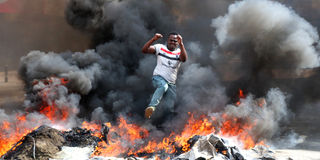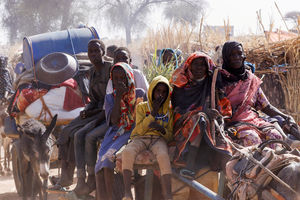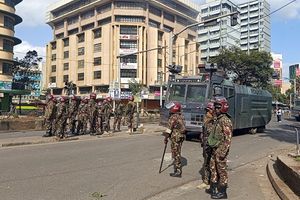
A protester jumps over a bonfire along Kenyatta Avenue in Nakuru City during the June 25, 2025 demonstrations.
Nairobi was on Thursday slowly shaking off the effects of Wednesday’s massive protest to mark the first anniversary of the June 25, 2024 Gen Z demonstrations and honour those killed by police on that occasion. Media reported 16 shot dead, more than 300 injured in Nairobi alone, with protests in 27 counties, including Mombasa, Kisumu, Kiambu, Nakuru, Nyeri and Kisii.
For the second time in as many years, troop carriers and APCs rolled out of military bases with Kenya Defence Forces standing guard to prevent protesters from overrunning the city and making good their threat to invade State House Nairobi, depose and harm the President. It was social unrest on a totally different scale and the government response was equally scaled up: razor wire fences went up around sensitive installations such as State House and Parliament, live coverage of the protests was banned, some stations were switched off and some social media platforms were restricted.
Young people were protesting the killing of their peers last year, during a protest against the Finance Bill, which they said imposed harsh taxes. The grievances have widened and include failure by the government to keep the promises it made last year, the corrupt sale of government job opportunities and tribalism in government employment. The protesters were, as is typical with them, quite bold in engaging and fighting the police, mounting their own barricades and stoning officers.
Youth frustration is real and has transformed into despair, especially after some senior officials threatened those who took part that they would be killed. It was alleged that 5,000 goons had been mobilised by so-called business owners to protect their premises.
Violence in the streets
However, there was looting and destruction of shops in many towns, a court house was partially burnt in Kikuyu and a police station razed in Makongeni in Thika.
These were serious protests, perhaps the worst in recent memory, if not ever. Now the question is, what does it all mean? And is there likelihood of the youth coming back to the streets, as they have threatened? Stopping this week’s protests was not easy, the government resorted to every tactic and deployed nearly all the resources at its disposal.
How much more violence in the streets is feasible? And how many before the pendulum of rioting overpowers the security forces and overruns government installations? And how many more deaths before the protests become even more widespread?
There has been an attempt to interpret the protests as tribal—members of one tribe against a president from another, but nothing could be further from the reality of the demos. The protesters describe themselves as leaderless and tribeless, and it is true they are.
Far worse danger lurks
President William Ruto calmed last year’s protests by shelving the tough tax measures, sacked the Cabinet and promised to do better. The young protesters now complain that the promises were insincere, that the sacked Cabinet secretaries were re-appointed, the tax measures re-introduced; in a word, nothing changed. It is not known whether the protesters are determined to hold more demos, but it also not clear what measures the government can take this time to cool the situation.
The economic situation is not good. Government expenditure has gone up Sh176 billion, despite the promise to cut—the State House budget increased 171 per cent, some of it going to more repairs. And in the first three months of the year, debt service soaked up 10 times more money than what was spent on development, meaning there is no reasonable expectation of a quick turnaround in fortunes.
There are other troubling signs. Allegations of gunrunning in Sudan, claims that arms from the Kenya Defence Forces were ending up in the hands of rebels in Sudan, fears that Nairobi is becoming a centre for arms dealing and the fact that the European Union has listed Kenya as a hotbed for money laundering, principally by well-heeled individuals with access to the public purse.
The biggest fear right now is that unless measures are taken to redress some of these issues, the Kenyan State could suffer some level of collapse: a situation where a country does not have a functioning government in the ordinary sense of the word —ability to control its territory, provide services and maintain law and order. This can be precipitated by an elite that cuts too many corners, does too many illegal deals and breaks too many laws.
So even as the country staggers towards some type of recovery from the protests, a far worse danger lurks.
***
Moses Kuria, former Trade Cabinet Secretary and now presidential advisor, has been maintaining that there will be no election in 2027. There are those who think that Kenya Kwanza is so certain it is going to lose, it will go to any lengths to avoid an election. But short of throwing in the towel and walking away, a proposal not to hold elections is likely to be strongly and widely resisted.







